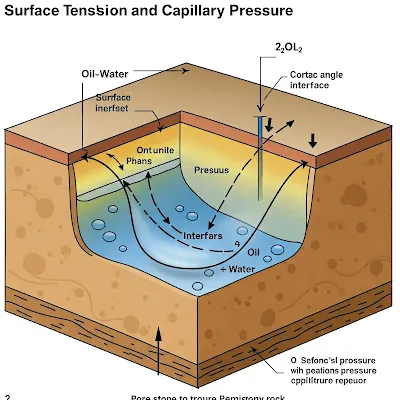Lecture in Surface Tension and Capillary Pressure in Reservoir Rocks
Essential Knowledge in Oil and Gas Engineering: Understanding Surface Tension and Capillary Pressure in Reservoir Rocks
 |
| Essential Knowledge in Oil and Gas Engineering: Understanding Surface Tension and Capillary Pressure in Reservoir Rocks |
In the field of oil and gas engineering, understanding the properties of reservoir rocks is crucial for effective exploration and production. One of the key topics that students in petroleum engineering must grasp is the concept of surface tension and capillary pressure in reservoir rocks. These phenomena play a significant role in the behavior of fluids within oil reservoirs, influencing how oil, gas, and water interact within the porous media of the rock.
In this blog post, I am excited to share an important lecture that delves into these critical concepts. The lecture, titled "Surface Tension and Capillary Pressure in Petroleum Reservoir Rocks," is designed to provide university students, particularly those studying petroleum and gas engineering, with a comprehensive understanding of these forces and their impact on reservoir performance.
What is Surface Tension?
Surface tension is a physical property that arises due to the cohesive forces between liquid molecules. In the context of petroleum reservoirs, surface tension affects how fluids such as oil, water, and gas interact at the interfaces within the porous rock. Understanding surface tension is essential because it influences fluid flow, distribution, and the overall recovery efficiency of hydrocarbons.
Capillary Pressure: A Key Factor in Reservoir Behavior
Capillary pressure, on the other hand, is the pressure difference between two immiscible fluids (such as oil and water) in a porous medium. It is directly related to surface tension and the wettability of the rock. Capillary pressure plays a critical role in determining how fluids are distributed within the reservoir and how they move through the rock pores. This concept is particularly important in the study of reservoir rock properties, as it affects oil recovery processes and the design of enhanced oil recovery (EOR) techniques.
Why This Lecture is Important for Students
For students specializing in petroleum engineering, particularly those taking courses on **Reservoir Rock Properties**, this lecture provides a deep dive into the theoretical and practical aspects of surface tension and capillary pressure. It covers:
- The fundamental principles of surface tension and capillary pressure.
- Their significance in reservoir engineering.
- Practical applications in oil and gas exploration and production.
Watch the Lecture on YouTube
To make this knowledge more accessible, I have uploaded the lecture on my YouTube channel, **"Oil Knowledge Fields"**. You can watch the full lecture by clicking on the link below:
[Watch the Lecture on YouTube]
Download the PowerPoint Presentation
For those who prefer to study at their own pace or need the slides for reference, I have also made the PowerPoint presentation available for download. The slides are packed with detailed explanations, diagrams, and examples to help you fully grasp the concepts.
[Download the PowerPoint Presentation]
### Conclusion
Understanding surface tension and capillary pressure is essential for anyone pursuing a career in petroleum and gas engineering. These concepts are not only fundamental to reservoir rock properties but also play a critical role in the development of efficient oil recovery strategies. I hope this lecture and the accompanying resources will be valuable to students and professionals alike.
Don’t forget to check out the lecture on YouTube and download the PowerPoint presentation to enhance your understanding of these important topics. Stay tuned to **"Oil Knowledge Fields"** for more insightful content on oil and gas engineering!
---
Feel free to customize the links and any additional details as needed. Good luck with your blog post!

Comments